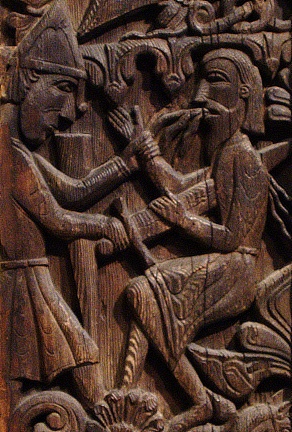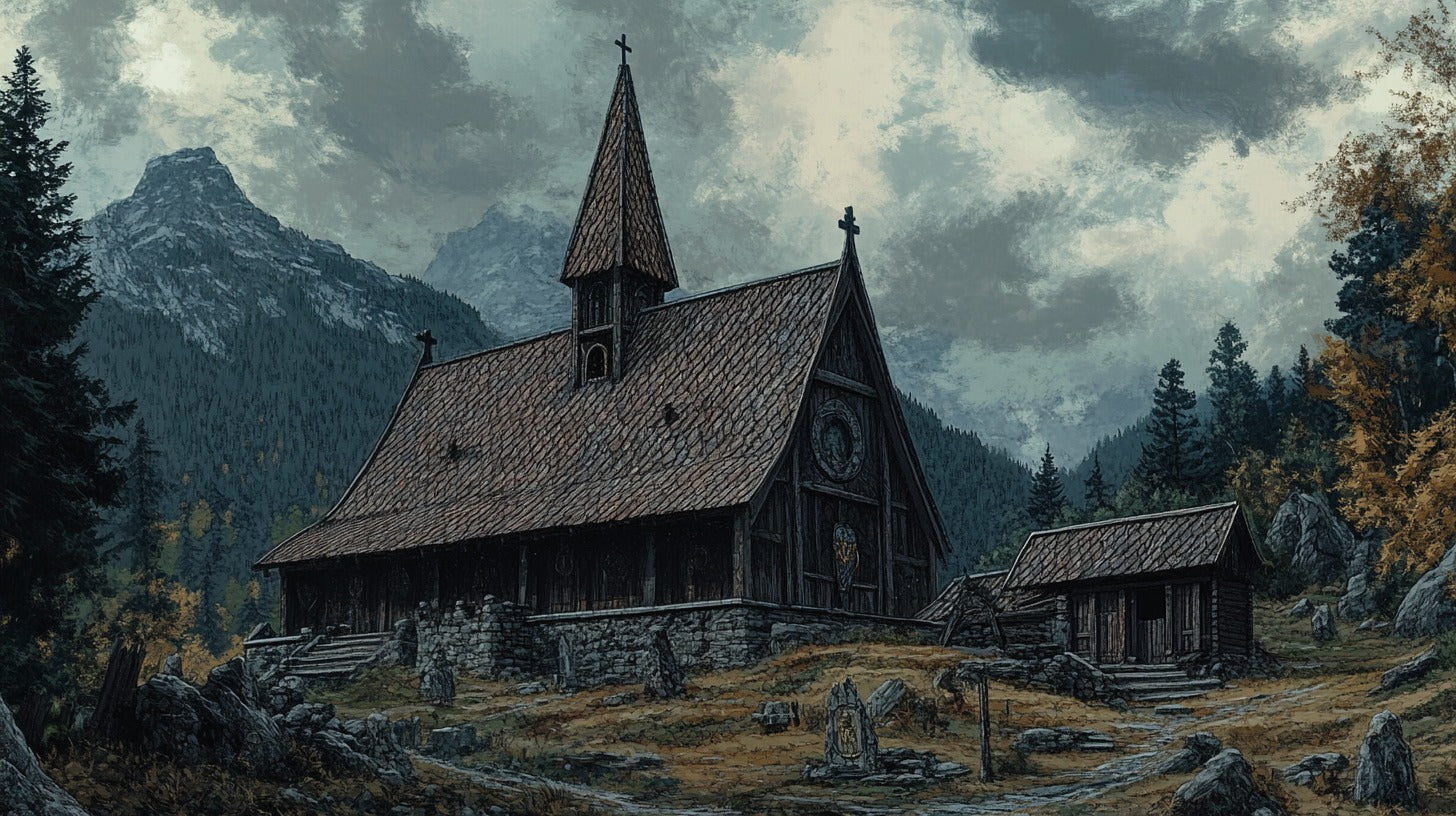The Hylestad Stave Church, once a proud structure in the village of Hylestad in Setesdal, Norway, stands as a remarkable example of medieval Norwegian architecture and craftsmanship. Although the church no longer exists in its original form, its intricately carved portals have survived, offering invaluable insights into 12th-century Scandinavian art, mythology, and religious practices.
Historical Context

The Urnes Stave Church / Photo: Karaian (CC BY 2.0).
Stave Churches in Norway
Stave churches were wooden Christian churches built in medieval Scandinavia, particularly Norway, between the 11th and 14th centuries. These structures are characterized by their post and lintel construction, with corner posts ("staves") providing the main support. At their peak, it is estimated that there were about 1,000 stave churches in Norway, but today only 28 remain standing in their original form.
Medieval Christianity in Scandinavia
The construction of stave churches coincided with the Christianization of Scandinavia. Norway officially adopted Christianity in the 11th century under King Olaf II, but the transition from Norse paganism was gradual. This period of religious change is reflected in the artwork of many stave churches, including Hylestad, which often incorporated both Christian and pre-Christian elements.
Architecture and Construction

Interior of the Urnes Stave Church / Photo: Lars-bh (CC BY-SA 4.0).
Structural Features
While the complete structure of the Hylestad Stave Church no longer exists, it is believed to have followed the typical design of other stave churches from the same period. These churches were characterized by their vertical wooden planks (staves) set on a stone foundation, with a raised central nave surrounded by an ambulatory.
Materials Used
Like other stave churches, Hylestad would have been primarily constructed of pine, which was abundant in Norway and naturally resistant to decay. The wood was often treated with tar for additional protection against the harsh Scandinavian weather.
Carved Portals

Description of Carvings
The most significant surviving elements of the Hylestad Stave Church are its richly carved portals. These portals, dating from approximately 1175-1200 CE, feature intricate relief carvings depicting scenes from Norse mythology and Christian symbolism. The carvings are executed in the Urnes style, characterized by flowing, intertwined animal and plant motifs.
Significance of Imagery
The imagery on the Hylestad portals is particularly noteworthy for its depiction of the Sigurd legend, a popular Norse saga. This blending of pagan mythology with a Christian structure illustrates the cultural transition occurring in Norway during this period. The high quality of the carvings also demonstrates the skill of medieval Norwegian woodcarvers.
Sigurd Legend Depictions

Overview of the Sigurd Saga
The Sigurd saga, also known as the Völsunga saga, is a legendary Norse tale about the hero Sigurd (also known as Siegfried in German traditions). The story involves dragons, magical rings, and themes of betrayal and revenge. Its popularity in medieval Scandinavia is evidenced by its frequent depiction in art, including on several stave church portals.
Specific Scenes on the Portals
The Hylestad portals depict several key scenes from the Sigurd saga. These include Sigurd killing the dragon Fafnir, Sigurd roasting Fafnir's heart, Sigurd listening to the birds after tasting the dragon's blood, and the hero Gunnar in the snake pit. These scenes are arranged in a narrative sequence, allowing viewers to "read" the story from the carvings. The detail and dynamism of these depictions make the Hylestad portals some of the most important surviving representations of the Sigurd legend in medieval Scandinavian art.
Preservation and Current Status

Dismantling and Relocation
The Hylestad Stave Church was dismantled in 1838, a fate shared by many stave churches during the 19th century as parishes grew and required larger buildings. Fortunately, the ornate portals were preserved.
Exhibition in Oslo Museum
Today, the carved portals from the Hylestad Stave Church are on display at the Museum of Cultural History in Oslo. Their preservation allows modern viewers to appreciate the artistic achievements of medieval Norwegian craftsmen and provides valuable material for scholars studying Norse art, mythology, and the transition from paganism to Christianity in Scandinavia.
Cultural and Historical Significance
The Hylestad Stave Church portals are of immense cultural and historical significance. They provide tangible evidence of the artistic and architectural traditions of medieval Norway, offering insights into the technical skills, aesthetic preferences, and narrative traditions of the time.
The portals are particularly valuable for their depiction of the Sigurd legend, providing one of the earliest and most complete visual narratives of this important Norse saga. This makes them crucial for understanding how mythological stories were transmitted and understood in medieval Scandinavian society.
Furthermore, the combination of pagan imagery within a Christian context reflects the complex process of religious transition in Norway. It demonstrates how pre-Christian traditions were not simply abandoned but often incorporated into new religious practices and art forms.
From an art historical perspective, the Hylestad portals are excellent examples of the Urnes style, the last phase of Viking Age animal art. Their preservation allows for detailed study of carving techniques, stylistic elements, and iconographic traditions of the late 12th century.
Conclusion
The Hylestad Stave Church, though no longer standing, lives on through its magnificently carved portals. These artifacts stand as a testament to the rich cultural heritage of medieval Norway, embodying the artistic skill, mythological traditions, and religious transitions of their time. As we study and admire these carvings today, we gain invaluable insights into the complex tapestry of belief, artistry, and storytelling that characterized Scandinavian society in the Middle Ages. The preservation and continued study of such artifacts ensure that the legacy of structures like the Hylestad Stave Church continues to inform our understanding of medieval European history and culture.
FAQ
-
When was the Hylestad Stave Church built?
While the exact construction date is unknown, the carved portals are dated to approximately 1175-1200 CE, suggesting the church was built around this time.
-
Why was the Hylestad Stave Church dismantled?
The church was dismantled in 1838, likely due to the need for a larger building to accommodate a growing parish, a common reason for the destruction of many stave churches in the 19th century.
-
What is the significance of the Sigurd legend depicted on the portals?
The Sigurd legend was a popular Norse saga. Its depiction on a church portal demonstrates the blending of pagan and Christian traditions in medieval Norway and provides valuable information about Norse storytelling and artistic traditions.
-
Where can the Hylestad Stave Church portals be seen today?
The carved portals are currently on display at the Museum of Cultural History in Oslo, Norway.
-
How many stave churches originally existed in Norway, and how many remain today?
It is estimated that there were about 1,000 stave churches in Norway at their peak. Today, only 28 remain standing in their original form.














